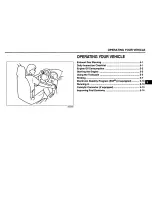
Mercedes-Benz strongly advises that you fit a
child restraint system to a rear seat.
The generic term child restraint system
The generic term child restraint system is used
in this Owner's Manual. A child restraint system
is, for example:
R
a baby car seat
R
a rearward-facing child seat
R
a forward-facing child seat
R
a child booster seat with a backrest and seat
belt guide
Mercedes-Benz recommends using a child
booster seat with a backrest.
The child restraint system must be appropriate
to the age, weight and size of the child.
Observe laws and legal requirements
Always observe the legal requirements when
using a child restraint system in the vehicle.
Make sure that the child restraint system is
approved in accordance with the valid test speci‐
fications and guidelines. Further information can
be obtained at a qualified specialist workshop.
Mercedes-Benz recommends that you use a
Mercedes-Benz Service Centre for this purpose.
Only use approved child restraint systems
Only child restraint systems that meet the fol‐
lowing UNECE standards are permitted for use in
the vehicle:
R
UN-R44
R
UN-R129 (i-Size child restraint systems)
Information on child restraint system approval
categories and details on the approval label on
the child restraint system (
/
page 54).
Detecting risks, avoiding danger
Securing systems for child restraint systems
in the vehicle
Only use the following securing systems for child
restraint systems:
R
the ISOFIX or i-Size securing rings
R
the vehicle's seat belt system
R
the Top Tether anchorages
Fitting an ISOFIX or an i-Size child restraint sys‐
tem is preferred.
Simply attaching to the securing rings on the
vehicle can reduce the risk of fitting the child
restraint system incorrectly.
When securing a child with the integrated seat
belt of the ISOFIX or i-Size child restraint sys‐
tem, always comply with the permissible gross
weight for the child and child restraint system
(
/
page 58).
Advantage of a rearward-facing child
restraint system
It is preferable to transport a baby or a small
child in a suitable rearward-facing child restraint
system. In this case, the child sits in the oppo‐
site direction to the direction of travel and faces
backwards.
Babies and small children have comparatively
weak neck muscles in relation to the size and
weight of their head. The risk of injury to the cer‐
vical spine during an accident can be reduced in
a rearward-facing child restraint system.
50 Occupant safety
Summary of Contents for EQC 350 4MATIC 2021
Page 2: ......
Page 3: ......
Page 9: ...Left hand drive vehicles 6 At a glance Cockpit...
Page 11: ...Instrument display 8 At a glance Indicator and warning lamps...
Page 13: ...10 At a glance Overhead control panel...
Page 15: ...12 At a glance Door operating unit and seat adjustment...
Page 17: ...14 At a glance Emergencies and breakdowns...
Page 451: ...Workshop see Qualified specialist workshop 448 Index...
Page 452: ......
Page 453: ......
















































